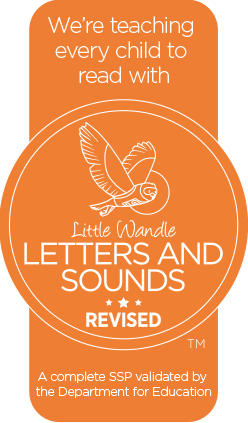Phonics
Phonics intent at Peover Superior
At Peover Superior we ensure our approach to teaching phonics and reading is accessible to all learners, regardless of background. Our aim is to ensure all children have access to a high-quality education with reading at the heart of everything we do. Our policy explains the way in which we teach early reading effectively.
Intent
Phonics (reading and spelling)
At Peover Superior Primary School we believe that all our children can become fluent readers and writers. This is why we teach reading using Little Wandle Letters and Sounds Revised, which is a systematic and synthetic phonics programme. We start teaching phonics as soon as the children start school in Reception and follow the Little Wandle Letters and Sounds Revised progression, which ensures children build on their growing knowledge of the alphabetic code, mastering phonics to read and spell as they move through school.
As a result, all our children are able to tackle any unfamiliar words as they read. At Peover Superior Primary School, we also model the application of the alphabetic code through phonics in shared reading and writing, both inside and outside of the phonics lesson and across the curriculum. We have a strong focus on language development for our children because we know that speaking and listening are crucial skills for reading and writing in all subjects.
Comprehension
We value reading as a crucial life skill. By the time children leave us, they read confidently for meaning and regularly enjoy reading for pleasure. Our readers are equipped with the tools to tackle unfamiliar vocabulary. We encourage our children to see themselves as readers for both pleasure and purpose.
Because we believe teaching every child to read is so important, we have a Reading Leader who drives the early reading programme in our school. At Peover Superior, this member of staff is Miss Crumbleholme. This person is highly skilled at teaching phonics and reading, and they monitor and support our reading team, so everyone teaches with fidelity to the Little Wandle Letters and Sounds Revised programme.
Implementation
Daily phonics lessons in Reception and Year 1
- We teach phonics for 30 minutes a day. In Reception, we build from 10-minute lessons, with additional daily oral blending games, to the full-length lesson as quickly as possible. Each Friday, we review the week’s teaching to help children become fluent readers.
- Children make a strong start in Reception: teaching begins in the first few weeks of the Autumn term.
- We follow the Little Wandle Letters and Sounds Revised expectations of progress:
- Children in Reception are taught to read and spell words using Phase 2 and 3 GPCs, and words with adjacent consonants (Phase 4) with fluency and accuracy.
- Children in Year 1 review Phase 3 and 4 and are taught t read and spell words using Phase 5 GPCs with fluency and accuracy.
Our policy is attached to the bottom of this page for more information on how we teach early reading.
Please see the website for more information around Little Wandle- there are videos and links to ways in which this will be taught at school.
https://www.littlewandlelettersandsounds.org.uk/resources/for-parents/
Phonics Screening Test
At the end of Year 1 all children's phonic knowledge is tested using the Phonics Screen. All Year 1 children in England take this test. Attainment in the Phonic Screen at Peover Superior has been consistently above national average.
In 2017 and 2018 Peover Superior was the highest attaining school for achieving the Year 1 phonics test in Cheshire East.
| Year | School | National |
| 2017 | 100% | 81% |
| 2018 | 100% | 83% |
| 2019 | 92% | 82% |
| 2020 | / | / |
| 2021 | / | / |
| 2022 | 100% | 75% |
| 2023 | 100% | 79% |
In phonics lessons children are taught three main things:
GPCs
They are taught GPCs. This stands for grapheme phoneme correspondences. This simply means that they are taught all the phonemes in the English language and ways of writing them down. These sounds are taught in a particular order. The first sounds to be taught are s, a, t, p.
Blending
Children are taught to be able to blend. This is when children say the sounds that make up a word and are able to merge the sounds together until they can hear what the word is. This skill is vital in learning to read.
Segmenting
Children are also taught to segment. This is the opposite of blending. Children are able to say a word and then break it up into the phonemes that make it up. This skill is vital in being able to spell words.

